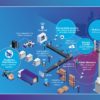Small cells for 5G: the challenges

Small cells for 5G: the challenges and how to overcome them
According to a Fortune Business Insights report, global investment in 5G small cell technology is set to increase from $175 million recorded in 2019, to $15.9 billion by 2026; a CAGR of 81.9%. Small cells will be an important part of 5G roll-out, especially in urban areas and in indoor settings, as millimetre wave (mmWave) experiences a high signal loss when penetrating building materials.

Further, their size means that small cell antennas can be easily and cost effectively deployed in urban and indoor settings; locations like shopping malls, medical lab training centers and hospitals, sports arenas, entertainment venues, education campuses, office buildings, manufacturing plants and enterprise facilities.
However, there are a number of challenges that come with both deploying and testing small cells: these networks must, after all, support very specific environments, devices and use cases.
Mobility and scalable UEs
When connected to a small cells network, users and devices must be able to move around a geographical area without significant degradation in connectivity: calls must not be dropped and high data rates should remain stable for all UEs. This could be a robot moving from one area of a factory to another, or a human subscriber walking and talking on their phone as they browse shops in a mall.
Network tests must include device mobility and different RF environments, and testing equipment must be able to accurately replicate real-world user behaviour profiles such as web browsing, emails, downloading files, video streaming and VoLTE, together with mobility across the RAN.
The infrastructure must also be resilient to different capacity challenges, supporting scalable numbers of UEs with high data capacity demands. Small cell networks in busy environments will have to handle a rapid fluctuation in numbers of users, and will have to handle traffic efficiently at maximum capacity.
Adequate network resources
Without adequate network resources – and without robust testing – the in-stadia experience for fans will be pretty poor. When a stadium is full of spectators when a game is on, for instance, visitors – and network users – would have to put up with buffering (or the network failing altogether) when uploading videos, and face dropped calls when trying to get in touch with friends. These might not seem comparable to high-risk scenarios in a manufacturing plant or during robotic surgery, but it’s these kinds of experiences which can make or break the operator/subscriber relationship.
This isn’t a question of whether or not to test the network, but how to adopt the right test strategy – i.e. a strategy that will maximize confidence that the network will deliver the service that subscribers demand. In designing a testing strategy, factors such as mobility, traffic mixes and overall system load need to be considered.
Tests must replicate real-world user behaviour while ensuring that the performance of the network is kept at its peak reliably and with stability. This means that UE emulation test tools should not compromise on the reliability and stability of the network for long periods of time. For example, ensuring that there are no short-cuts taken in the 5G stack such as the physical layer and Medium Access Control Layers, which are key to accurate UE feedback to the small cell, including scheduler performance under different mobility and fading conditions. It is also important to ensure stateful operation of the small cell, and further, that signalling messages at the higher layers are not missed which could impact the number of Call Attempts per Second in a highly populated area.
Capacity and coverage
Providing coverage to areas with dense numbers of end users is the primary goal of small cells for 5G. Think of a business/consumer setting such as an office: if the network isn’t providing stable peak data rates then employees using the network will be unable to work as productively.
In an industrial setting meanwhile, machinery and devices must have consistently high performance and connectivity. Not delivering on capacity requirements in these settings could result in a failure to produce and deliver products as targeted, impacting productivity and revenues. Imagine a network failure in a car factory, for instance. This is a setting which relies on highly tuned, just-in-time operations involving tightly co-ordinated activities from suppliers as well as the manufacturer. If one element is running slow as a result of a network issue, the rest of the system cannot easily slow down to cope. Instead, the whole line is likely to experience bottlenecks in places and excess materials in others. The end result could be a need to pause the entire line while the problem is fixed.
Operators and NEMs will need to validate different types of small cells, across sub-6GHz and mmWave. It is essential that small cells can still provide coverage and reasonable capacity at the edge of the cell. This means that in testing small cells, such corner cases cannot be ignored.
Latency and bandwidth
In many settings where small cells for 5G will be deployed – such as training venues, hospitals and manufacturing plants – there will be different requirements for both latency and bandwidth that the network must be able to support. In use cases involving a large number of sensors and actuators (such as those used in a smart factory), the network will need to deliver low bandwidth to a massive number of devices, and support lower latency – down to milliseconds. Mission critical applications, such as remote surgery may require high bandwidth and ultra-low latency. Applications such as video surveillance may require medium latency and bandwidth requirements.
If the latency and bandwidth requirements can’t be met, this adds risk to the very sensitive applications aforementioned and/or disruption to major supply chains. The small cells network must therefore be validated with advanced solutions to support the range of different applications and the inherent demands on differing levels of latency and bandwidth. It doesn’t make sense (and would not be at all cost effective) to deliver a network that has huge amounts of bandwidth and ultra-low latency, if there aren’t the applications for it.
Flexible and open architectures – small cells for 5G
According to Small Cells Forum, OpenRAN-based units will account for 77% of new small cell deployments in 2026, up from just 12% this year. OpenRAN is very much in its infancy and has not been deployed at scale yet and across a broad range of different environments.
With open approaches and the use of multiple vendors, ensuring latency, capacity and overall performance of the network becomes more challenging. Individual components parts of the network must be tested and assured, as if one fails the impact will be across the network, and may not always be easily attributable to a single component, causing further complications. NEMs and systems integrators will also have to guarantee that they meet requirements of the multi-vendor network in its entirety. With multiple vendors and the need to meet multiple service level agreements, the risks around guaranteeing latency, stability and capacity are multiplied.
Successfully testing an open ecosystem with small cells is critical. Service providers must be able to identify and resolve problems across multi vendor networks, starting from day one. They must use a comprehensive platform with modules for lab validation, field deployment and service assurance.
TMLite and TM500 family of products
VIAVI works closely with existing and prospective customers to help them determine optimum testing strategies that deliver the robustness they and their network end-users need. This support runs throughout the whole small cells for 5G testing lifecycle, from the beginning of the testing journey validating individual components, to complete end-to-end testing. And we’re constantly developing existing and new products to do this. Our newly-launched TMLite, for example, enables vendors to deploy focused functional test tools earlier in the development cycle, kickstarting their journey in test and measurement.
In a more compact package and with cost-effectiveness in mind, we’re helping vendors to gain access to the market-leading TM500 technology and family. TMLite is well suited to smaller set-ups, making it ideal for testing private networks and small cell deployments. However, its capabilities can also extend beyond small cells, enabling partners and customers to test a wider variety of scenarios and environments.
We understand the needs of our customers, and with TMLite, we’re helping NEMs, operators and enterprises access validation tools that can support the broad requirements for small cells performance. The wider TM500 family also means we’re supporting stakeholders with small and large budgets while still accommodating complex technical requirements and ensuring we’re the perfect partner throughout the testing lifecycle. Overall VIAVI products can help ensure networks are able to hit those all-important criteria: reliability, coverage, capacity, performance, mobility and stability.
Video: watch how TMLite enhances 5G network test scalability and productivity.




